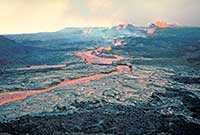|
COMETS EARTH JUPITER KUIPER BELT MARS MERCURY METEORITES NEPTUNE OORT CLOUD PLUTO SATURN SOLAR SYSTEM SPACE SUN URANUS VENUS ORDER PRINTS
PHOTO CATEGORIES SCIENCEVIEWS AMERICAN INDIAN AMPHIBIANS BIRDS BUGS FINE ART FOSSILS THE ISLANDS HISTORICAL PHOTOS MAMMALS OTHER PARKS PLANTS RELIGIOUS REPTILES SCIENCEVIEWS PRINTS
|
Related Documents
Download Options
Lava channels are narrow, curved or straight open pathways through which lava moves on the surface of a volcano. The volume of lava moving down a channel fluctuates so that the channel may be full or overflowing at times and nearly empty at other times. During overflow, some of the lava congeals and cools along the banks to form natural levees that may eventually enable the lava channel to build a few meters above the surrounding ground. Lava pours down a well-developed lava channel near a series of erupting vents on the northeast rift zone of Mauna Loa Volcano. The eruption started from fissures in the volcano's summit caldera on March 25 and migrated to these vents on March 26. This lava channel fed an `a`a flow that traveled 25 km until lava broke from the channel to feed another flow on March 29. The channel width varied 20 to 50 m and extended to within 1 to 2 km of the flow front. A scientist is standing near the channel (thin white vertical line in center). |
